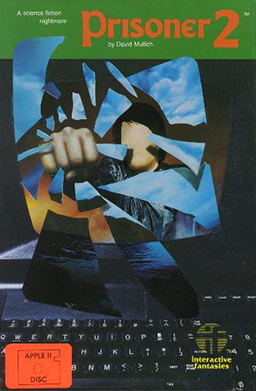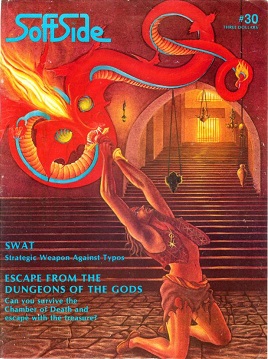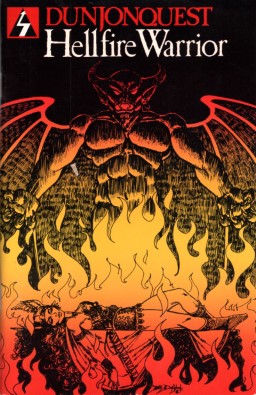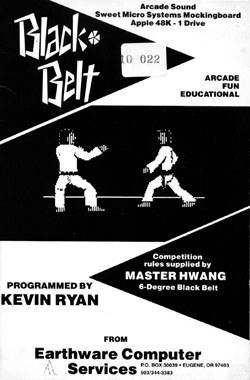
Zork is a text adventure game first released in 1977 by developers Tim Anderson, Marc Blank, Bruce Daniels, and Dave Lebling for the PDP-10 mainframe computer. The original developers and others, as the company Infocom, expanded and split the game into three titles—Zork I: The Great Underground Empire, Zork II: The Wizard of Frobozz, and Zork III: The Dungeon Master—which were released commercially for a range of personal computers beginning in 1980. In Zork, the player explores the abandoned Great Underground Empire in search of treasure. The player moves between the game's hundreds of locations and interacts with objects by typing commands in natural language that the game interprets. The program acts as a narrator, describing the player's location and the results of the player's commands. It has been described as the most famous piece of interactive fiction.

Underwurlde is a 1984 action-adventure platform video game in the Sabreman series by Ultimate Play the Game for the ZX Spectrum and Commodore 64. The player controls the adventurer Sabreman as he jumps between platforms in a castle and its caverns to find an escape past the exit guardians. Underwurlde features about 600 flip screen areas. Unlike other games of its time, Sabreman is not injured when touched by enemies and is instead knocked backwards. Underwurlde is the second game in the series, between Sabre Wulf and Knight Lore, and released shortly before the latter for the ZX Spectrum in late 1984. Another developer, Firebird, ported the game to the Commodore 64 the next year.

Softalk was an American magazine of the early 1980s that focused on the Apple II computer. Published from September 1980 through August 1984, it featured articles about hardware and software associated with the Apple II platform and the people and companies who made them. The name was originally used on a newsletter of Apple Software pioneer company, Softape, who in 1980 changed its name to Artsci Inc.

Super Invader is a fixed shooter video game written by Japanese programmer M. Hata for the Apple II and published by Creative Computing Software in November 1979. Super Invader is a clone of Space Invaders.
Crystal Computing, later renamed Design Design, was a British video game developer founded in 1982 by Chris Clarke and Ian Stamp while students at the University of Manchester. Graham Stafford, Neil Mottershead, Simon Brattel and Martin Horsley, joined the company as it expanded. The company's first software release was a compilation of games for the Sinclair ZX81, though it was with the ZX Spectrum that Crystal found its greatest success. A deal with the machine's manufacturer Sinclair to distribute Crystal's Zeus Assembler gave the company sufficient funds for a major marketing campaign for their next product, Halls of the Things, an arcade adventure game that became their most successful title.

The Prisoner 2 is a video game published in 1982 by Edu-Ware. It is a remake of the 1980 game The Prisoner.

Datamost was a computer book publisher and computer game company founded by David Gordon and based in Chatsworth, California. Datamost operated in the early 1980s producing games and other software mainly for the Apple II, Commodore 64 and Atari 8-bit computers, with some for the IBM PC. It also published educational and reference materials related to home computers and computer programming.

SoftSide is a defunct computer magazine, begun in October 1978 by Roger Robitaille and published by SoftSide Publications of Milford, New Hampshire.

Serpentine is a maze video game written by David Snider for the Apple II and published by Broderbund in 1982. Serpentine's gameplay and visuals are similar to the Konami arcade game, Jungler, released the previous year. It was ported to the Commodore 64 and Atari 8-bit computers. A VIC-20 version was licensed to Creative Software.

Transylvania is an adventure video game published by Penguin Software. It was released for the Apple II in 1982 followed by ports to the Atari 8-bit computers and Commodore 64. A Mac conversion was published in 1984, then versions for the Amiga, Atari ST, and MS-DOS in 1985.

Sargon III is a computer chess program. It is a sequel to Sargon II.

The Thompson Twins Adventure is a 1984 graphic adventure game that was distributed by Computer and Video Games magazine as a promotional 7" flexi disc "freebie" along with its October 1984 issue. The game is based on the Thompson Twins' single "Doctor! Doctor!", and features the Thompson Twins band members as the protagonists. The unusual storage format of the game showcases an experimental technique pioneered by the London-based Flexi Records label, and places the game alongside a small handful of other games distributed on grooved disks. This format never became established and The Thompson Twins Adventure is today valued more for its nostalgic and artifactual value than for its ludological aspects which have been uniformly panned by critics.

Gumball is a video game written for the Apple II by Veda Hlubinka-Cook and published by Broderbund in 1983. It was ported to the Atari 8-bit computers, and Commodore 64. The player controls the valves of a maze-like machine to sort gumballs by color.

Hellfire Warrior is a dungeon crawl video game for the Apple II, Commodore PET, and TRS-80 published by Automated Simulations in 1980. A port to Atari 8-bit computers was released in 1982. Hellfire Warrior is the direct sequel to 1979's Temple of Apshai. Two expansion packs were published.

Adventure in Time is a text adventure written by Paul Berker for the Apple II. It was published in 1981 by Phoenix Software, followed by a version for Atari 8-bit computers in 1983.

The Queen of Phobos is a graphical text adventure for the Apple II published by American studio Phoenix Software in 1982.

Caves and Caverns is a 1982 fantasy role-playing game adventure published by Judges Guild.

The Final Conflict is a strategy video game written by Thomas G. Cleaver for the Apple II and published by Hayden Software in 1982. A version for Atari 8-bit computers followed in 1983.

The Book of Adventure Games is a book by Kim Schuette published in 1984 by Arrays, Inc.

Black Belt is a fighting game published in 1984 by Earthware Computer Services for the Apple II and Commodore 64. It was released as an educational video game supplement to real life taekwondo training. The player spars with another human or computer opponent while strictly adhering to the rules of the sport including scoring and penalties. Black Belt is the fourth game from Earthware and the second programmed by Kevin Ryan for the company.



















